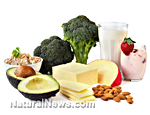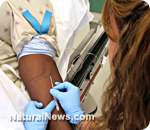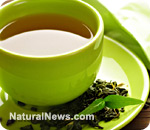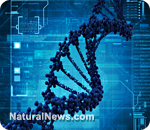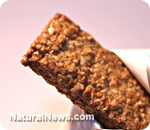Break a sugar addiction within a week using three easy steps
(NaturalNews) Refined sugar is a drug that is similar to opiates in its power to become addicted to it. The Journal of Psychoactive Drugs stated in a study published in 2010 that sugar releases euphoric endorphins in some people's brains in a manner very similar to that of certain drugs which are commonly abused.
"Sugar addiction" follows the same pathways in the brain that a habit-forming drug does. Fortunately, sugar cravings can be stopped within a week of withdrawing from the white crystals.

The entire scope of drug addiction has been observed in people with sugar addiction. There are cravings, an escalation of tolerance levels, and dramatic withdrawal symptoms associated with sugar addiction that parallel that of both prescription and non-prescription "street" drugs. In addition, sugar addicts often become narcotic addicts, according to the above study.
The study, performed at California State University, found that children of alcoholic parents often had a "sweet tooth," and were more likely to become alcoholics themselves when they became adults. There are also genetic markers connecting sugar addictions with alcoholism, bulimia, and obesity.
Whereas someone on the SAD might normally reach for a quart of their favorite ice cream and the better part of a bag of cookies for an evening snack, homemade bread with raw honey is a wiser, healthier choice.
According to MyFitnessPal.com, there are approximately 290 calories in just one cup of a commercial brand of vanilla ice cream, along with 16 grams of fat and 30 grams of refined sugar. By comparison, a 1.5 gram slice of homemade whole grain bread contains 100 calories, 1.5 grams fat, and 18 grams of complex carbohydrates.
Drizzling a whole tablespoon of raw honey onto the slice of bread adds 70 calories and 15 grams of sugar. Rather than eating 28 grams of refined sugar from a cup of vanilla ice cream alone, sugar cravings are reduced by eating 15 grams of raw honey.
In addition, the destructive chemicals in refined sugar are replaced with the scientifically proven anti-microbial, anti-oxidant and appetite-regulating benefits of raw honey.
Trail mixes, as long as they do not contain added candy or sugar- sweetened fruit, contain an interesting combination of complex carbohydrates, proteins, and good fats which help tide an individual over until meal time. There is just enough natural sugar in trail mix to offer an energy boost without a sugar spike.
Sources:
Pubmed.gov, Journal of Psychoactive Drugs. .2010 Jun; 42(2):147-51. "Sweet preference, sugar addiction and the familial history of alcohol dependence: shared neural pathways and genes," by JL Fortuna.
http://www.ncbi.nlm.nih.gov/pubmed/20648910
MyFitnessPal.com, "Breyers Vanilla Ice Cream"
http://www.myfitnesspal.com/food/calorie-chart-nutrition-facts
Calorie Count. About. Com, "Calories in Really Raw Honey"
http://caloriecount.about.com/calories-really-raw-honey-i191541
Pubmed.gov, Biotechnology Research International. 2011; 2011: 917505. "Antibacterial Efficacy of Raw and Processed Honey." DP Mohapatra and V Thakur, et al.
http://www.ncbi.nlm.nih.gov/pmc/articles/PMC3042689/
Pubmed.gov, Journal of the American Dietary Association. 2009 Jan; 109(1):64-71. "Total antioxidant content of alternatives to refined sugar." KM Phillips and MH Carlsen, et al.
http://www.ncbi.nlm.nih.gov/pubmed/19103324
Pubmed.gov, Journal of the American College of Nutrition. 2010 Oct; 29(5):482-93. "Effect of honey versus sucrose on appetite, appetite-regulating hormones, and post meal thermogenesis." DE Larson-Meyer and KS Willis, et al.
http://www.ncbi.nlm.nih.gov/pubmed/21504975
About the author:
Brad Chase is the President of ProgressiveHealth.com. His website provides articles and natural remedies to help people solve their health concerns.
Learn more: http://www.naturalnews.com/037337_sugar_addiction_habits_raw_honey.html#ixzz27gAqyXFR
"Sugar addiction" follows the same pathways in the brain that a habit-forming drug does. Fortunately, sugar cravings can be stopped within a week of withdrawing from the white crystals.

The entire scope of drug addiction has been observed in people with sugar addiction. There are cravings, an escalation of tolerance levels, and dramatic withdrawal symptoms associated with sugar addiction that parallel that of both prescription and non-prescription "street" drugs. In addition, sugar addicts often become narcotic addicts, according to the above study.
The study, performed at California State University, found that children of alcoholic parents often had a "sweet tooth," and were more likely to become alcoholics themselves when they became adults. There are also genetic markers connecting sugar addictions with alcoholism, bulimia, and obesity.
Raw, organic fruits and vegetables form the first step in breaking a sugar addiction
The first step in breaking a sugar addiction is to make sure all fruits and vegetables consumed are 100 percent organic. Organic fruits and vegetables are full of natural sugars, or complex carbohydrates. Not only does organic produce taste better, the complex carbohydrates break down slower than simple carbohydrates do. This means the body does not send "craving" messages as quickly to the brain.Substitute pastries with whole grain bread and raw honey
While those on an ancestral diet may cringe at the suggestion, a person who is just beginning to transition from the Standard American Diet (SAD) by breaking a sugar addiction can dramatically reduce sugar cravings by eating a slice of homemade whole grain bread drizzled with raw, unpasteurized local honey.Whereas someone on the SAD might normally reach for a quart of their favorite ice cream and the better part of a bag of cookies for an evening snack, homemade bread with raw honey is a wiser, healthier choice.
According to MyFitnessPal.com, there are approximately 290 calories in just one cup of a commercial brand of vanilla ice cream, along with 16 grams of fat and 30 grams of refined sugar. By comparison, a 1.5 gram slice of homemade whole grain bread contains 100 calories, 1.5 grams fat, and 18 grams of complex carbohydrates.
Drizzling a whole tablespoon of raw honey onto the slice of bread adds 70 calories and 15 grams of sugar. Rather than eating 28 grams of refined sugar from a cup of vanilla ice cream alone, sugar cravings are reduced by eating 15 grams of raw honey.
In addition, the destructive chemicals in refined sugar are replaced with the scientifically proven anti-microbial, anti-oxidant and appetite-regulating benefits of raw honey.
Break the need for crunchy snacks with raw nuts and trail mixes
Raw nuts and seeds along with natural trail mixes made with dried, unsweetened fruit are perfect for the person who is breaking a sugar addiction. Raw nuts and seeds offer protein, energy, and healthy plant fats.Trail mixes, as long as they do not contain added candy or sugar- sweetened fruit, contain an interesting combination of complex carbohydrates, proteins, and good fats which help tide an individual over until meal time. There is just enough natural sugar in trail mix to offer an energy boost without a sugar spike.
Sources:
Pubmed.gov, Journal of Psychoactive Drugs. .2010 Jun; 42(2):147-51. "Sweet preference, sugar addiction and the familial history of alcohol dependence: shared neural pathways and genes," by JL Fortuna.
http://www.ncbi.nlm.nih.gov/pubmed/20648910
MyFitnessPal.com, "Breyers Vanilla Ice Cream"
http://www.myfitnesspal.com/food/calorie-chart-nutrition-facts
Calorie Count. About. Com, "Calories in Really Raw Honey"
http://caloriecount.about.com/calories-really-raw-honey-i191541
Pubmed.gov, Biotechnology Research International. 2011; 2011: 917505. "Antibacterial Efficacy of Raw and Processed Honey." DP Mohapatra and V Thakur, et al.
http://www.ncbi.nlm.nih.gov/pmc/articles/PMC3042689/
Pubmed.gov, Journal of the American Dietary Association. 2009 Jan; 109(1):64-71. "Total antioxidant content of alternatives to refined sugar." KM Phillips and MH Carlsen, et al.
http://www.ncbi.nlm.nih.gov/pubmed/19103324
Pubmed.gov, Journal of the American College of Nutrition. 2010 Oct; 29(5):482-93. "Effect of honey versus sucrose on appetite, appetite-regulating hormones, and post meal thermogenesis." DE Larson-Meyer and KS Willis, et al.
http://www.ncbi.nlm.nih.gov/pubmed/21504975
About the author:
Brad Chase is the President of ProgressiveHealth.com. His website provides articles and natural remedies to help people solve their health concerns.
Learn more: http://www.naturalnews.com/037337_sugar_addiction_habits_raw_honey.html#ixzz27gAqyXFR

